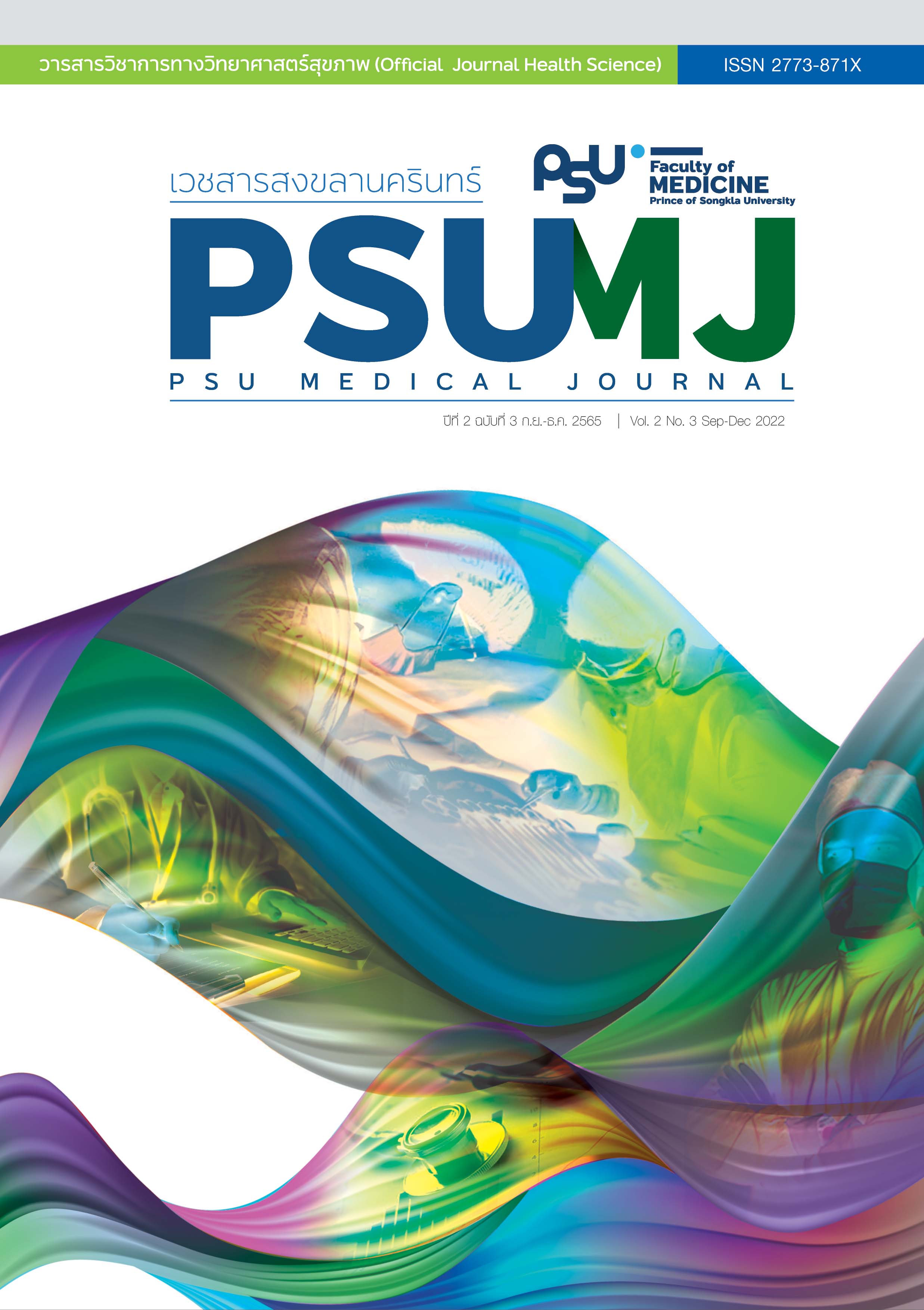Basic Lung Ultrasonography in Critically Ill Patients: a Literature Review
DOI:
https://doi.org/10.31584/psumj.2022255073Keywords:
lung, basic ultrasound, critically ill patientsAbstract
Nowadays, lung ultrasonography is a popular choice to diagnose critically ill patients with conditions such as pneumonia, atelectasis and pneumothorax because the ultrasonography has higher sensitivity and specificity than chest x-rays. The ultrasonography can be easily performed at the bedside and does not require patient transfers that may increase the opportunity of endotracheal tube and ventilator circuit dislodgement. Moreover, there is no radiation exposure associated with ultrasound. Lung ultrasonography is operator-dependent. therefore, knowledge, skill and experience are needed to improve the accuracy of the test. This review consists of the basic use of an ultrasound machine and lung ultrasonography for the diagnosis of common diseases in critically ill patients.
References
Lichtenstein DA. BLUE-protocol and FALLS-protocol: two applications of lung ultrasound in the critically ill. Chest 2015;147:1659–70.
Lichtenstein D, Axler O. Intensive use of general ultrasound in the intensive care unit. Intensive Care Med 1993;19:353–5.
Mayo PH, Beaulieu Y, Doelken P, Feller-Kopman D, Harrod C, Kaplan A, et al. American College of Chest Physicians/ La Société de Réanimation de Langue Française statement on competence in critical care ultrasonography. Chest 2009;135:1050–60.
Hendin A, Koenig S, Millington SJ. Better with ultrasound. Chest 2020;158:2082–9.
Miller A. Practical approach to lung ultrasound. BJA Educ 2016;16:39–45.
Miller A. Lung ultrasound, sonoanatomy, and standard views [monograph on the Internet]. Oxford: Oxford University Press; 2019 [cited 2022 Feb 23]. Available from: https://oxfordmedicine. com/view/10.1093/med/9780198749080.001.0001/med- 9780198749080-chapter-14.
Bouhemad B, Mongodi S, Via G, Rouquette I. Ultrasound for “lung monitoring” of ventilated patients. Anesthesiology 2015;122:437–47.
Mojoli F, Bouhemad B, Mongodi S, Lichtenstein D. Lung ultrasound for critically ill patients. Am J Respir Crit Care Med 2019;199:701–14.
Smit MR, de Vos J, Pisani L, Hagens LA, Almondo C, Heijnen NFL, et al. Comparison of linear and sector array probe for handheld lung ultrasound in invasively ventilated icu patients. Ultrasound Med Biol 2020;46:3249–56.
Bobbia X, Chabannon M, Chevallier T, Coussaye JE de L, Lefrant JY, Pujol S, et al. Assessment of five different probes for lung ultrasound in critically ill patients: A pilot study. Am J Emerg Med 2018;36:1265–9.
Koenig S, Mayo P, Volpicelli G, Millington SJ. Lung ultrasound scanning for respiratory failure in acutely ill patients. Chest 2020;158:2511–6.
Lichtenstein D. Lung ultrasound in the critically ill. Curr Opin Crit Care 2014;20:315-22.
Shrestha GS, Weeratunga D, Baker K. Point-of-care lung ultrasound in critically ill patients. Rev Recent Clin Trials 2018;13:15–26.
Steppan J, Diaz-Rodriguez N, Barodka VM, Nyhan D, Pullins E, Housten T, et al. Focused review of perioperative care of patients with pulmonary hypertension and proposal of a perioperative pathway. Cureus [serial on the Internet]. 2018 Jan 15 [cited 2021 Sep 6]; 10(1): e2072. Available from: https://www. cureus.com/articles/10247-focused-review-of-perioperativecare- of-patients-with-pulmonary-hypertension-and-proposalof- a-perioperative-pathway.
Volpicelli G, Mayo P, Rovida S. Focus on ultrasound in intensive care. Intensive Care Med 2020;46:1258–60.
Shkolnik B, Judson MA, Austin A, Hu K, D’Souza M, Zumbrunn A, et al. Diagnostic accuracy of thoracic ultrasonography to differentiate transudative from exudative pleural effusion. Chest 2020;158:692–7.
Marini C, Fragasso G, Italia L, Sisakian H, Tufaro V, Ingallina G, et al. Lung ultrasound-guided therapy reduces acute decompensation events in chronic heart failure. Heart 2020;106:1934–9.
Touw HRW, Tuinman PR. Lung ultrasound: routine practice for the next generation of internists. Neth J Med 2015;73:8.
Peck M, Macnaughton, P. Focused intensive care ultrasound [monograph on the Internet]. Oxford: Oxford University Press;2019 [cited 2022 Feb 23]. Available from: https://oxfordmedicine. com/view/10.1093/med/9780198749080.001.0001/med- 9780198749080.
Lichtenstein D, Mezière G. A lung ultrasound sign allowing bedside distinction between pulmonary edema and COPD: the comet-tail artifact. Intensive Care Med 1998;24:1331–4.
Wongwaisayawan S, Suwannanon R, Sawatmongkorngul S, Kaewlai R. Emergency Thoracic US: The Essentials. Radio Graphics 2016;36:640–59.
Francisco Neto MJ, Rahal Junior A, Vieira FAC, Silva PSD da, Funari MB de G. Advances in lung ultrasound. Einstein São Paulo 2016;14:443–8.
Gargani L. Ultrasound of the Lungs. Heart Fail Clin 2019;15:297– 303.
Soldati G, Inchingolo R, Smargiassi A, Sher S, Nenna R, Inchingolo CD, et al. Ex vivo lung sonography: morphologicultrasound relationship. Ultrasound Med Biol 2012;38:1169–79.
Via G, Lichtenstein D, Mojoli F, Rodi G, Neri L, Storti E, et al. Whole lung lavage: a unique model for ultrasound assessment of lung aeration changes. Intensive Care Med 2010;36:999–1007.
Bouhemad B, Liu Z-H, Arbelot C, Zhang M, Ferarri F, Le- Guen M, et al. Ultrasound assessment of antibiotic-induced pulmonary reaeration in ventilator-associated pneumonia. Crit Care Med 2010;38:84–92.
Bouhemad B, Brisson H, Le-Guen M, Arbelot C, Lu Q, Rouby J-J. Bedside Ultrasound Assessment of Positive End-Expiratory Pressure–induced Lung Recruitment. Am J Respir Crit Care Med 2011;183:341–7.
Soummer A, Perbet S, Brisson H, Arbelot C, Constantin J-M, Lu Q, et al. Ultrasound assessment of lung aeration loss during a successful weaning trial predicts postextubation distress. Crit Care Med 2012;40:2064–72.
Volpicelli G, Elbarbary M, Blaivas M, Lichtenstein DA, Mathis G, Kirkpatrick AW, et al. International evidence-based recommendations for point-of-care lung ultrasound. Intensive Care Med 2012;38:577–91.
Chiumello D, Mongodi S, Algieri I, Vergani GL, Orlando A, Via G, et al. Assessment of Lung Aeration and Recruitment by CT Scan and Ultrasound in Acute Respiratory Distress Syndrome Patients. Crit Care Med 2018;46:1761–8.
Monastesse A, Girard F, Massicotte N, Chartrand-Lefebvre C, Girard M. Lung Ultrasonography for the Assessment of Perioperative Atelectasis: A Pilot Feasibility Study. Anesth Analg 2017;124:494–504.
Mirabile C, Malekzadeh-Milani S, Vinh TQ, Haydar A. Intraoperative hypoxia secondary to pneumothorax: The role of lung ultrasound. Pediatr Anesth 2018;28:468–70.
Downloads
Published
How to Cite
Issue
Section
License
Copyright (c) 2022 Author and Journal

This work is licensed under a Creative Commons Attribution-NonCommercial-NoDerivatives 4.0 International License.








